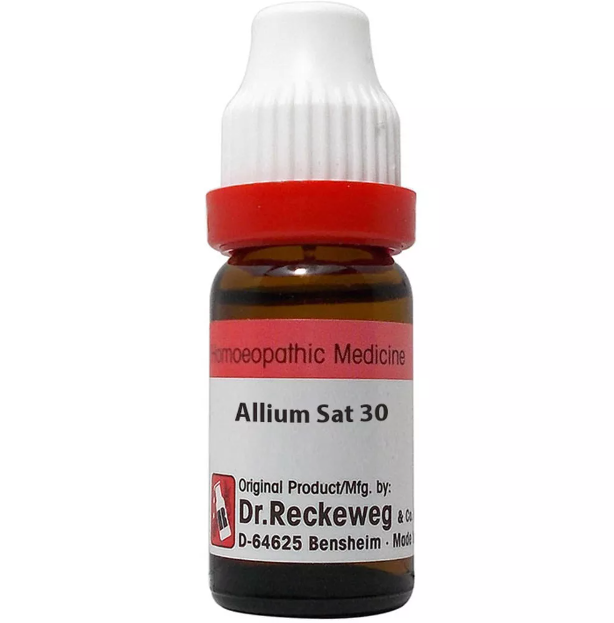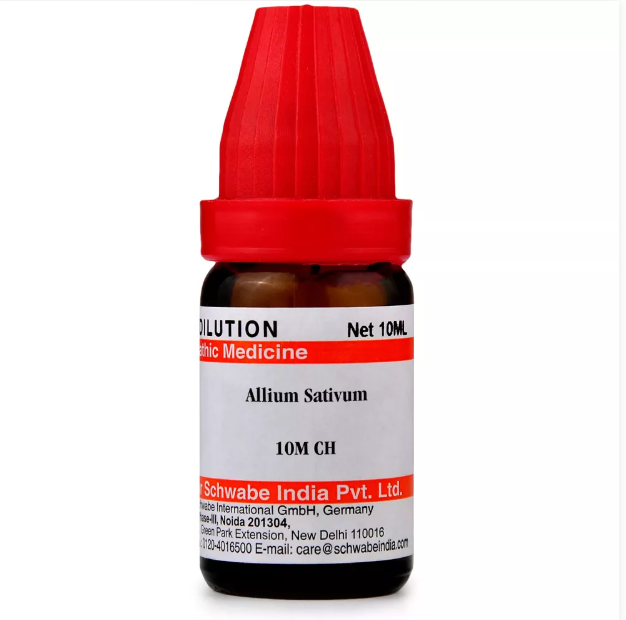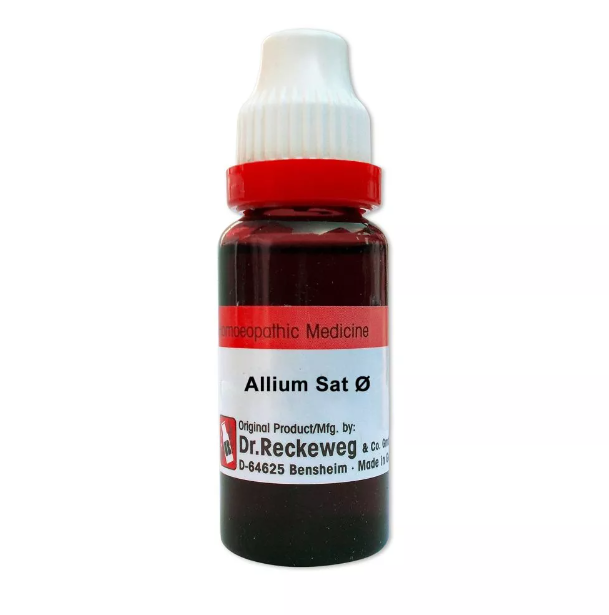ALLIUM SATIVUM Q, 6C, 12C, 30C, 200C, 1M, 10M USES AND SYMPTOMS
 Allium Sativum (Garlic)
Allium Sativum (Garlic)
Works directly on the intestinal mucous membrane, promoting peristalsis. Effective for colitis with pathological flora. Exhibits vasodilatory properties. Arterial hypotension typically begins 30 to 45 minutes after taking twenty to forty drops of the tincture.
Ideal for individuals with a fleshy build experiencing dyspepsia and catarrhal issues. Suited for those with a high standard of living, especially those who consume more food, particularly meat, than fluids. Pain in the hips, psoas, and iliac muscles. Beneficial for pulmonary tuberculosis.
Head:
- Feeling of heaviness; pulsation in temples.
- Catarrhal deafness.
Mouth:
- Sweetish saliva after meals and at night.
- Sensation of a hair on the tongue or in the throat.
Stomach:
- Voracious appetite.
- Burning eructations (dyspepsia).
- Minimal dietary changes cause trouble.
- Constipation with constant dull pain in the bowels.
- Pale tongue with red papillae.
Female:
- Breast pain and swelling.
- Eruptions in the vagina and on breasts and vulva during menses.
Respiratory:
- Constant rattling of mucus in the bronchi.
- Morning cough after leaving the bedroom, with sticky, hard-to-raise mucus.
- Sensitivity to cold air.
- Dilated bronchi with foul-smelling expectoration.
- Darting pain in the chest.
Relationship:
- All-s., according to Dr. Teste, belongs to the Bry. group, which includes Lyc., Nux-v., Coloc., Dig., and Ign. These remedies deeply affect all flesh-eating animals and have a particular applicability to non-vegetarians rather than exclusive vegetarians.
Compare:
- Caps., Ars., Seneg., Kali-n.
Complementary:
- Ars.
Antidote:
- Lyc.

SYMPTOMS OF ALLIUM SATIVUM
 Head:
Head:
- Feeling of heaviness in the head.
- Pulsation in the temples.
- Catarrhal deafness.
Mouth:
- Sweetish saliva after meals and at night.
- Sensation of a hair on the tongue or in the throat.
Stomach:
- Voracious appetite.
- Burning eructations (dyspepsia).
- Minimal dietary changes cause trouble.
- Constipation with constant dull pain in the bowels.
- Pale tongue with red papillae.
Female:
- Breast pain and swelling.
- Eruptions in the vagina and on breasts and vulva during menses.
Respiratory:
- Constant rattling of mucus in the bronchi.
- Morning cough after leaving the bedroom, with sticky, hard-to-raise mucus.
- Sensitivity to cold air.
- Dilated bronchi with foul-smelling expectoration.
- Darting pain in the chest.
Relationship:
- Belongs to the Bry. group, affecting non-vegetarians more than exclusive vegetarians. Similar to Caps., Ars., Seneg., Kali-n.
Complementary:
- Ars.
Antidote:
- Lyc.
selection of the potency
Individualization:
- Homeopathy is based on the principle of treating the individual, not just the disease. The unique symptoms and characteristics of the person are crucial in determining the most suitable potency.
Intensity of Symptoms:
- The intensity of the symptoms guides the choice of potency. If the symptoms are intense and acute, a lower potency (e.g., 6C, 30C) might be considered. For chronic conditions with less intensity, higher potencies (e.g., 200C, 1M) may be appropriate.
Sensitivity of the Patient:
- Some individuals are more sensitive to homeopathic remedies, while others may require higher potencies. The practitioner considers the patient’s sensitivity when selecting the potency.
Acute vs. Chronic Conditions:
- Lower potencies are often used for acute conditions, while higher potencies may be considered for chronic or long-standing issues.
Previous Response to Potencies:
- The patient’s response to previous homeopathic treatments helps guide the choice of potency. If a particular potency has been effective in the past, it may be repeated or adjusted as needed.
Vital Force and Susceptibility:
- Homeopathy views illness as a disturbance in the vital force. The practitioner assesses the patient’s overall vitality and susceptibility to determine the appropriate potency.
Aggravation or Amelioration:
- The direction of the symptom response (aggravation or amelioration) after taking a remedy can influence the choice of potency.
Miasmatic Considerations:
- In classical homeopathy, the concept of miasms (inherited disease tendencies) is considered. The practitioner take this into account when selecting the potency.
Practitioner Experience:
- The experience and preference of the homeopathic practitioner play a role. Some practitioners may have success with certain potencies based on their clinical experience.
SAFETY INFORMATION
- Do not exceed the recommended dose by physician
- Keep out of the reach of children
- Store in a cool dry place away from direct sunlight
- Maintain half an hour gap between food/drink/any other medicines and homoeopathic medicine
- Avoid any strong smell in the mouth while taking medicine e.g. camphor, garlic, onion, coffee, hing
Medicine images use for reference only selection of homeopathic medicine depends on the individual’s specific symptoms and overall constitution. Moreover, homeopathy is a holistic system of medicine that treats the individual as a whole. In addition to addressing the physical symptoms, it takes into account the emotional and mental state of the person. Consequently, it’s crucial to consult with a qualified homeopathic practitioner for personalized treatment.
The information provided on this website is intended solely for educational purposes. Always seek the advice of your physician or other qualified health provider.
